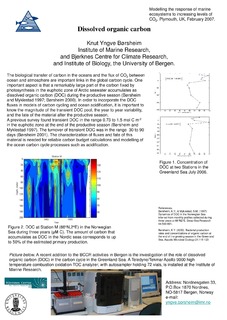| dc.contributor.author | Børsheim, Knut Yngve | |
| dc.date.accessioned | 2007-06-21T15:34:29Z | |
| dc.date.issued | 2007-02-12 | |
| dc.identifier.uri | http://hdl.handle.net/11250/116909 | |
| dc.description | Presented at the workshop : Modelling the response of marine ecosystems to increasing levels of CO2. Plymouth, UK, February 12-14, 2007. | en |
| dc.description.abstract | The biological transfer of carbon in the oceans and the flux of CO2between ocean and atmosphere are important links in the global carbon cycle. One important aspect is that a remarkably large part of the carbon fixed by photosynthesis in the euphotic zone of Arctic seawater accumulates as dissolved organic carbon (DOC) during the productive season (Børsheim and Myklestad 1997; Børsheim 2000). In order to incorporate the DOC fluxes in models of carbon cycling and ocean acidification, it is important to know the magnitude of the transient DOC pool, the year to year variability, and the fate of the material after the productive season.
A previous survey found transient DOC in the range 0.73 to 1.5 mol C m-2in the euphotic zone at the end of the productive season (Børsheim and Myklestad 1997). The turnover of transient DOC was in the range 30 to 90 days (Børsheim 2001). The characterization of fluxes and fate of this material is needed for reliable carbon budget calculations and modelling of the ocean carbon cycle processes such as acidification. | en |
| dc.format.extent | 381241 bytes | |
| dc.format.mimetype | application/pdf | |
| dc.language.iso | eng | en |
| dc.publisher | Institute of Marine Research | en |
| dc.subject | marine ecosystems | en |
| dc.title | Dissolved organic carbon | en |
| dc.type | Conference object | en |
